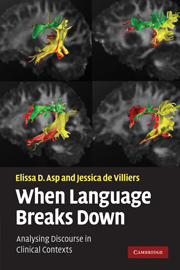Book contents
- Frontmatter
- Contents
- List of figures
- List of tables
- Acknowledgements
- Transcription conventions
- Introduction
- 1 Introduction to clinical discourse analysis
- 2 Theoretical and clinical contexts
- 3 Talk and speech – conversation analysis and intonation in English
- 4 Grammar
- 5 Phase and contexts of culture and situation
- 6 Study design
- 7 Differential diagnosis and monitoring
- 8 Cognitive models, inferencing and affect
- 9 Modelling information across domains
- Closing remarks
- Notes
- Appendix A Some basic grammatical terminology and relations
- Appendix B Inventory of codes
- References
- Author index
- Subject index
8 - Cognitive models, inferencing and affect
Published online by Cambridge University Press: 05 June 2012
- Frontmatter
- Contents
- List of figures
- List of tables
- Acknowledgements
- Transcription conventions
- Introduction
- 1 Introduction to clinical discourse analysis
- 2 Theoretical and clinical contexts
- 3 Talk and speech – conversation analysis and intonation in English
- 4 Grammar
- 5 Phase and contexts of culture and situation
- 6 Study design
- 7 Differential diagnosis and monitoring
- 8 Cognitive models, inferencing and affect
- 9 Modelling information across domains
- Closing remarks
- Notes
- Appendix A Some basic grammatical terminology and relations
- Appendix B Inventory of codes
- References
- Author index
- Subject index
Summary
Introduction
This chapter outlines approaches to top-down cognitive modelling and inferencing, and addresses functionally grounded work on affect. We describe each area and illustrate its potential for addressing questions in clinical discourse analysis. We also review recent work from neuroimaging and lesion studies to suggest some of the relevant neural systems. As usual, we draw on various disciplinary perspectives and theoretical models. Our practical motivation here is to use what works, and has potential for coding corpora in the various linguistic contexts and situations encountered doing clinical discourse analysis.
Cognitive models in general characterize information bundles of various kinds. Perhaps the most familiar are those used to represent words or word-like concepts. Models for words may be more or less detailed depending on the tolerance for elaboration within a particular framework, but morphosyntactic class, inflection and distribution features are typically indicated. How a word is pronounced – its phonological form and regular phonetic variants – will be spelt out in phonological and phonetic representations. Semantic features are often specified only at superordinate levels as in THING/EVENT or merely indexed through the use of the ‘CAPS-for-concept’ convention. Thus, the model for the lexeme ‘cat’ will include the information that it is a common count noun, with the inflectional and distributional features of this class – it can occur as head of a noun phrase and it inflects for plural number /s/. It is pronounced /kæt/.
- Type
- Chapter
- Information
- When Language Breaks DownAnalysing Discourse in Clinical Contexts, pp. 135 - 167Publisher: Cambridge University PressPrint publication year: 2010



